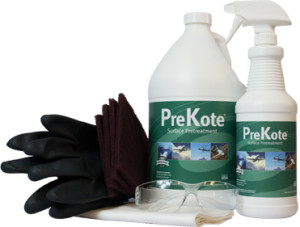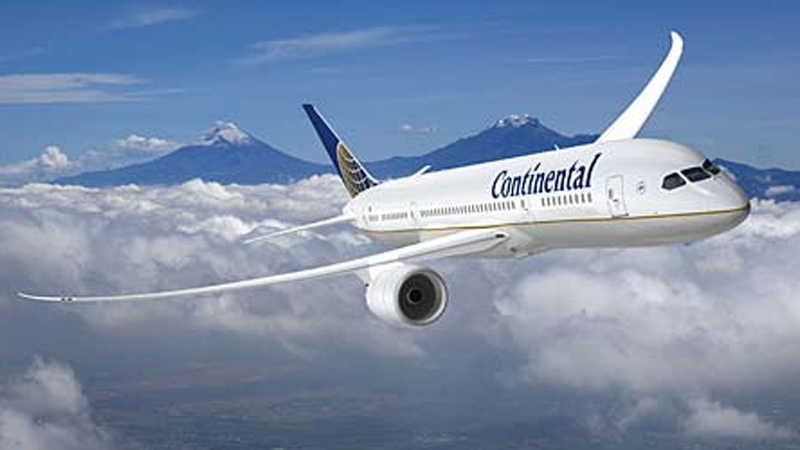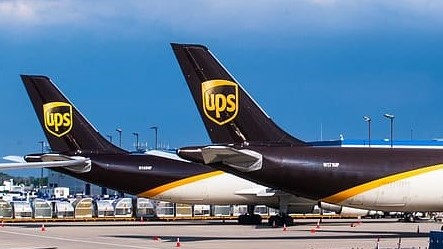PreKote Repair Kits prepare metal for paint touch-ups for up to 300 square feet and does not have to be treated as hazardous waste. PreKote Repair Kits are non-toxic and hexavalent chromium-free. Also, unlike one-use pens, PreKote Repair Kits can be stored for future use.
Contents
1 Gallon of PreKote | 32 oz. Trigger Spray Container | 1 Pair of Protective Goggles | 1 Pair of Rubber Gloves | 4 Aluminum Oxide, Fine Grit Scrub Pads | 6 Lint Free Dry Wipes | 1 Illustrated PreKote Application Guide | 1 Field Repair Instruction Sheet | 1 PreKote SDS
PreKote® Benefits
• Fastest and easiest pretreatment process
• Provides maximum corrosion protection
• Ensures superior paint adhesion and flexibility
• Saves valuable time and money
• Minimizes number of chemicals used
• Reduces overall process time, getting aircraft back into service faster
• Available in both liquid and wipes
• Use on large surfaces, immersion, or touch-ups
• Safest product available
• Non-toxic: Hexavalent chromium-free*
• Non-hazardous; non-flammable; low VOCs
• Significantly reduces water usage
• Does not automatically trigger CIU status
• Significantly reduces HAZMAT shipping and storage, PPE, and wastewater treatment costs
• Reduces total product and process life cycle costs
Safety Benefits
PreKote has a long list of environmental, health, and safety benefits. PreKote does non contain chrome and is non-toxic, non-hazardous, non-flammable, non-corrosive, CFC free, odor free, does not deplete ozone, and the liquid is also readily biodegradable upon disposal. Because PreKote is non-hazardous, users can reduce HAZMAT shipping and storage charges. The all-in-one product is simple and easy to use, and requires less rinsing which reduces water consumption.
The US Environmental Protection Agency (EPA) found PreKote to have environmentally preferable chemistry. PreKote has been recognized with the Design for the Environment (DfE) award. The EPA has also determined that PreKote is not one of the six core metal finishing effluent operations and does not trigger categorical industrial user (CIU) status.
Industries that use this product:
SDS & Document Library
Product Info:
FAQs:
Instructions
Field Repair Instruction Sheet- Download file
This kit contains enough material to repair a 2 ft by 2ft square area
Note: PreKote (4 oz) and Rinse Water (8 oz) will be used in three (3) steps: Only use 1/3 of each bottle during each step.
Technical Info
The studies conducted by coating industry leaders proved the superior efficiency of the PreKote system. PreKote not only performed beyond industry expectations but added savings and benefits never before achieved. The PreKote process can save up to 40 percent in time and labor compared to the chromate conversion process. Subsequent studies have shown that by eliminating chromate conversion coatings in the painting process, savings of up to $2.23 per square foot can be realized. What impact could this have on your business?
The 1998 Ogden Air Logistics Report, AETC Bans Alodine Article, AETC Final Report, C-130 Operational Report, and Testing on Missile Silo at F.E. Warren support the successful use of PreKote as a chromate conversion coating replacement:
Technical documents can be found in the Document Library.
PreKote's non-hazardous formula and unbeatable performance makes it the pretreatment of choice. It's an all-in-one, easy-to-use product which saves users valuable time and money. Multiple tests conducted by the Department of Defense (DOD) and other agencies have confirmed aircraft treated with PreKote held up better than those treated with conversion coatings.
PreKote is extremely versatile and can be used on any painted and paintable surface. It can be used on aluminum, anodized aluminum, cadmium, magnesium, titanium, steel, composites and plastics. In short, if you can paint it, you can PreKote it.
PreKote's application process is very quick and easy because it's an all-in-one product. That means you'll save by not having to apply other products such as alkaline wash, acids, de-oxidizers, chromate conversion coatings or solvent wipes. With PreKote, there is little to no masking required.
After passing numerous paint system specification tests by the US Air Force, Aerospace OEMs, and USAF flight-testing, the USAF specified PreKote as the only replacement for chromated conversion coatings in the T.O. 1-1-8, the umbrella Technical Order for aircraft painting.
The PreKote process is faster because it's easy and requires the least amount of products. The main steps are:
1. Rinse the aircraft
2. Apply PreKote and scrub horizontally
3. Reapply PreKote and scrub vertically
4. Rinse.
PreKote is incredibly versatile and can be used on jobs of any size. PreKote comes in both liquid and wipes. For larger applications either spray the solution on or immerse the parts. For smaller applications, spray the solution on or use the pre-saturated wipes.
Yes, PreKote wipes are an excellent alternative to toxic, chromated touch-up pens. They are much easier to use, safer, less costly and provide better results.
Yes, parts can be immersed in PreKote. Contact Pantheon Technical Services at 888.608.7888 for advice on immersion processes.
The application process cleans the surface and changes the surface tension which creates an extremely strong bond for coatings to stick to. This strong bond prevents corrosion.
Yes. PreKote has passed numerous tests and has both military and commercial approvals. In fact, the USAF has specified that PreKote is the only replacement for chromated conversion coatings in the T.O. 1-1-8, the umbrella technical order for aircraft painting. PreKote has been qualified and is being used by Air Canada, Delta, Southwest, United Parcel Service (UPS), and American Eagle among others. Many of these customers have obtained OEM approval or NTOs to use PreKote. In addition, OEMs including Dassault Aviation and Mooney Airplane Company have approved and implemented PreKote for production aircraft. Contact Pantheon Technical Services at 888.608.7888 for the full PreKote approval list.
PreKote is extremely safe. It's non-hazardous, non-toxic, and quickly biodegradable. It has a pH of approximately 10–11.5. Chromated conversion coatings (such as Alodine) are highly corrosive acids (pH of 1.3–3.0), contain a known carcinogen, do not biodegrade, and are extremely hazardous to humans.
No. PreKote is safe for these materials.
Yes. It can be used on surfaces previously treated with other surface pretreatments.
Yes, PreKote is used extensively by the USAF on scuffed primer and topcoat. The application process is the same as for new or stripped surfaces.
Only three tools are needed; all available through Aviall:
1. Pump sprayer with nozzle
2. Aluminum oxide pads (3M Scotch-Brite 7447 non-woven pad 280-400 grit; for MILITARY: A-58054, Type I, Grade B)
3. For bigger jobs we recommend flexible pad holders that can attach to poles.
You will also need municipal water for rinsing.
Please see the PreKote SDS available on pantheonchemical.com. We recommend wearing eye protection and rubber gloves, but please contact your company's Health & Safety Officer for your company's specific PPE policies and protocols.
Yes. PreKote can be used on any paintable surface
No. Only paintable surfaces.
No. PreKote does not contain toxic vapors or fumes, so normal air circulation is sufficient.
Please see the PreKote SDS for first aid procedures.
Applying PreKote twice ensures complete coverage.
Rinsing between applications is not required for the PreKote chemistry to work. The application process is designed to generate as little waste water as possible.
Rinsing between applications is not required for the PreKote chemistry to work. The application process is designed to generate as little waste water as possible.
No, the first scrubbing application of PreKote is meant to remove the metal oxide layer. If the part is deoxidized prior to PreKote, a single application of PreKote with a two-minute dwell, immediately followed by a rinse is adequate.
PreKote works best with high-quality primers. It is compatible with any modern direct metal, chrome, non-chrome, epoxy, urethane primer, or topcoat from major manufacturers.
Primers and paints can be applied as soon as the surface is completely dry. PreKote dry times are similar to that of water dry times. If ovens or heated air blowers are available, PreKote can be dried at temperatures of up to 150°F.
Prime or paint within 24 hours of the PreKote application. If the environment is dirty or the part is subject to the accumulation of dust and oil, 24 hours is the maximum suggested time before priming in order to achieve the best finish possible. If it's been more than 24 hours, or there is obvious dirt, dust, fuel, or oil, wipe the surface with a lint-free cloth lightly dampened with PreKote to remove the contamination. Proceed with primer when dry.
Yes. In most cases you will get a water break-free surface, indicating the part is clean and properly pretreated within 2-10 seconds.
The surface may still be dirty or have an oxide layer. In this case, scrub the surface in question with PreKote. If repeated scrubbings do not yield a water break-free surface, there may be an issue with the rinse water. However, if the surface is clean the primer will stick even without a water break-free surface.
Simply reapply enough PreKote to fully wet the surface, lightly scrub, and immediately rinse off.
Applying paint over a PreKote surface that has not been rinsed will cause paint adhesion failures. PreKote must be rinsed off while still wet.
No, PreKote is not recommended for cleaning silicone contamination. Generally, the best means of removing silicone contamination is to sand out the contamination with fine aluminum oxide sand paper, then proceed with the normal PreKote application process.
Prekote contains no hazardous chemicals. However, depending upon the process used, as well as other materials and chemicals used, it's best to check with municipal waste stream for disposal.
It depends upon the dispensing method. Higher volume dispensing systems (drum pumps) will treat 120–160 square feet per gallon. Low volume trigger spray bottles will yield 200–300 square feet per gallon of PreKote.
No, but masking is recommended for any material not going to be primed and painted, including cockpits and windows.
No, PreKote does not leach cadmium. PreKote operates in the alkaline range (pH=10-11.5) and therefore has no propensity to leach cadmium from cadmium-plated parts.
PreKote Application Training
PreKote Application for USAF F-16
PreKote Application for B1B Bomber






